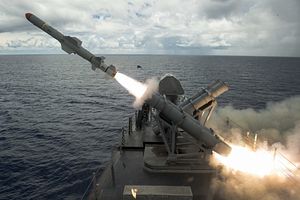The Independence-class Littoral Combat Ship (LCS) USS Coronado has successfully conducted a live-fire exercise of the GM-84D Harpoon Block 1C missile system near the coast of Guam on August 22, the U.S. Navy reports. The Harpoon missile, an all-weather, over-the-horizon, anti-ship missile system, reportedly successfully destroyed a surface target at significant distance beyond the ship’s visual range. “Coronado’s successful firing of the harpoon over-the-horizon missile system demonstrates the lethality of LCS while deployed overseas,” the U.S. Navy statement reads.
“LCS will play an important role in protecting shipping and vital U.S. interests in the maritime crossroads,” said U.S. Navy Rear Admiral Don Gabrielson, the commander of Task Force 73. “Its ability to pair unmanned vehicles like Fire Scout with Harpoon missiles to strike from the littoral shadows matters — there are over 50,000 islands in the arc from the Philippines to India; those shallow crossroads are vital world interests.”
A MQ-8B Fire Scout unmanned aerial system and MH-60S Seahawk helicopter reportedly provided targeting support for the Harpoon missile. “Harpoon and Fire Scout showcase one of the growing tool combinations in our modular LCS capability set and this complex shot demonstrates why LCS has Combat as its middle name,” Gabrielson added. The U.S. Navy operates two LCS variants, the Independence and Freedom class. There have been repeated concerns over the LCS’ ability to perform in combat. For example, both LCS designs did not envision the need for anti-ship missiles. The USS Coronado was the first LCS to be fitted with an advanced anti-ship missile system, the so-called Advanced Harpoon Weapon Control System (AHWCS) — two launcher structures installed athwartships.
During RIMPAC 2016, the USS Coronado conducted a live fire test of a Harpoon missile with mixed results (See: “RIMPAC 2016: US Navy Test-Fires Anti-Ship Missile From Littoral Combat Ship”). “The missile was launched from a canister installed on the USS Coronado’s forward deck. Yet, while the launch of the missile was successful, the Harpoon failed to hit its over-the-horizon target,” I reported on back then. The 2016 test firing did confirm that the Harpoon can be launched from a LCS without impacting its structure. “Lessons from the RIMPAC test informed preparations and helped set the team up for success this time,” the U. Navy notes in its August 22 statement.
The USS Coronado arrived at Changi Naval Base in Singapore in October 2016 as part of a rotational forward deployment to the U.S. Navy’s 7th Fleet area of operations–the first time that an Independence-class LCS has been deployed to Southeast Asia. En route to Singapore, the Coronado suffered an engineering casualty in the Western Pacific in August 2016. (See: “Dropping Like Flies: Third US Navy Littoral Combat Ship Out of Action”). LCS have been accident prone and also had to deal with various technical problems and human error in the last two years (See: “Three Times a Charm: US Navy Littoral Combat Ship Damaged Again”).
































